



All four games played in Round 4 of the London Chess Classic on 12 December 2009 ended in draws. They were all fighting draws which were only concluded after full-blooded battles.

Waiting for the round to begin: Vladimir Kramnik, Luke McShane, Michale
Adams, Nigel Short

The two top seeds: Magnus Carlsen, Vladimir Kramnik
In many ways the star of today’s round were the chess fans themselves. They came in their droves. Tournament director Malcolm Pein warned us to brace ourselves for a bumper crowd on the Saturday and he wasn’t wrong. The first three days of the congress were very well attended, but the chess audience today was awesome. The auditorium was packed with fans, as was the commentary room, and it was just as well that the organisers had thoughtfully planned further commentary in the foyer of the Olympia Conference Centre as it was definitely needed. Even more people were busy playing the game. Blitz and rapidplays events were being played in the foyer and a weekend tournament got underway besides the festival events that started on Tuesday. As an old-timer who has attended chess tournaments in England’s capital for more than forty years, I’ve not seen anything quite like this since the Fischer boom of the mid-1970s. In addition, we were visited by some more continental chess organisers and journalists and they were heard to comment in very favourable terms about the variety of chess entertainments available at Olympia.

To the chess... Michael Adams has a pretty good record against Vladimir Kramnik. They have met nearly 40 times over the board (including blitz and less serious encounters) and Adams is +1 overall. One of their most important meetings was in the 1999 FIDE World Knock-Out Championship in Las Vegas when Adams eliminated Kramnik in the quarter-final via a rapidplay play-off. The following year Adams beat Kramnik at the Russian’s favourite tournament, Dortmund, thereby ending Kramnik’s 82-game unbeaten run which had lasted well over a year. Adams beat him again in 2004 and 2005 and in fact has not lost a significant game to him for more than nine years. So Vladimir Kramnik would have been keen to take his revenge. But Adams was in very good form today. Playing Black, he gave up the two bishops and then a pawn to neutralise the ex-world champion’s pressure and steered the game towards a sterile opposite-coloured bishops endgame. Admittedly, a draw was probably not what the big crowd wanted to see but it was subtly played and a valuable lesson in how to keep a formidable player at bay.
Kramnik,Vladimir (2772) - Adams,Michael (2698) D37
London Chess Classic London ENG (4), 12.12.2009
1.d4 Nf6 2.c4 e6 3.Nf3 d5 4.Nc3 Be7 5.Bf4 0-0 6.e3 Nbd7 7.a3 c5 8.cxd5
Nxd5 9.Nxd5 exd5 10.dxc5 Nxc5 11.Be5 Bg4 12.Be2 Ne6 13.h3 Bxf3 14.Bxf3 d4 15.Bxd4
Nxd4 16.Qxd4 Qxd4 17.exd4 Rac8 18.0-0 Rc7 19.Rad1 Rd8 20.Rfe1 Kf8 21.Re2 g6
22.g3 Bf6 23.d5 Be7 24.Kg2 Bd6 25.Rde1 Rc5 26.Be4 Rdc8 27.f4 Rc1 28.Kf3 Rxe1
29.Rxe1 Rc5 30.g4 a5 31.a4 Rc4 32.b3 Rc3+ 33.Re3 Rxe3+ 34.Kxe3 h6 35.f5 gxf5
36.Bxf5 Ke7 37.h4 f6 38.Bc8 b6 39.Ke4 Bg3 40.h5 Bh4 41.Kf5 Bg5 42.Kg6 Kd6 43.Be6
Ke7 44.Bc8 Kd6 45.Be6 Ke7 46.Bc8 Kd6 1/2-1/2. [Click
to replay]

Vladmir Kramnik and Michael Adams analyse with GMs Stephen
Gordon (left) and
Jonathan Rowson (right) for the visitors in London and for the Playchess audience.
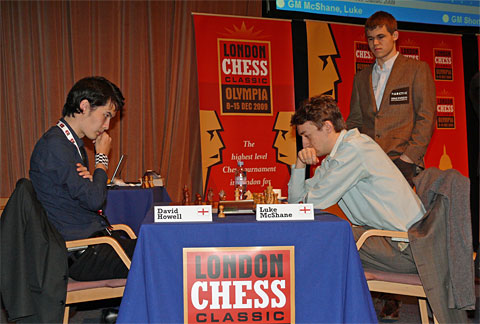
Magnus Carlsen kibitzes in the game David Howell vs Luke McShane
Appearances can be deceptive in chess. All the pieces other than pawns disappeared from the board in McShane-Howell in double quick time and I suppose some spectators might have thought this was a cunning ruse to get the game over with and agree a draw. But I think this is most unlikely. Most experienced chessplayers know that a king and pawn endgame, even with symmetrical pawn structures, can be a very dangerous animal. One slip, or a faint positional weakness, and it can be curtains. You don’t swap off your last minor or major piece without doing a lot of checking and double-checking in case there is some little nuance which you may have overlooked. It was something of a gamble on David Howell’s part as he had the disadvantage of a pair of doubled pawns – just the sort of problem that can be fatal in a king and pawn endgame – but it paid off. McShane probed and prodded in expert fashion but Howell’s defence stood firm.
McShane,Luke (2615) - Howell,David (2597) A15
London Chess Classic London ENG (4), 12.12.2009
1.Nf3 Nf6 2.c4 g6 3.Nc3 d5 4.cxd5 Nxd5 5.Qa4+ Nc6 6.Ne5 Qd6 7.Nxc6 Qxc6
8.Qxc6+ bxc6 9.g3 Bg7 10.Bg2 Rb8 11.b3 0-0 12.Bb2 Nxc3 13.Bxc3 Bxc3 14.dxc3
c5 15.0-0-0 Rb6 16.c4 Rd6 17.Rd5 Bb7 18.Rxd6 Bxg2 19.Rdd1 Bxh1 20.Rxh1 Rd8 21.Rd1
Rxd1+ 22.Kxd1 Kf8 23.Kd2 Ke8 24.Ke3 Kd7 25.g4 f6 26.Ke4 Ke6 27.h3 f5+ 28.Kf4
Kf6 29.g5+ Ke6 30.e4 fxe4 31.Kxe4 Kd6 32.f4 e6 33.h4 a6 34.a3 a5 35.Kf3 e5 36.Ke4
exf4 37.Kxf4 Ke6 38.Ke4 Kd6 39.Kf4 Ke6 40.Ke4 1/2-1/2. [Click
to replay]

Luke McShane and David Howell analyse with Chris Ward, Jon
Rowson and Lawrence Trent
Once again a lot of attention focused on Magnus Carlsen’s game. The last time he met Hikaru Nakamura was in a four-game rapidplay match in Oslo only two weeks ago, when the American won 3-1 so that must have been in the back of his mind. Carlsen played White and managed to isolate Hikaru Nakamura’s e6 pawn but it transpired his position was not as good as it appeared. Carlsen even found himself obliged to surrender a pawn. The game came down a queen ending and Carlsen secured a perpetual check.
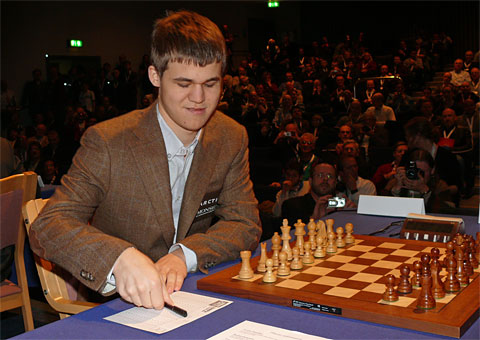
The star of the show in London: Norwegian GM Magnus Carlsen

Round four under way in London

Carlsen,Magnus (2801) - Nakamura,Hikaru (2715) D17
London Chess Classic London ENG (4), 12.12.2009 [John Saunders]
1.d4 d5 2.c4 c6. The Slav defence to the Queen's Gambit, which is currently all the rage at super-GM level. One small positional detail is that Black's light-squared bishop on c8 often has a bit more scope than is the case in the Queen's Gambit Declined after 2...e6. 3.Nf3 Nf6 4.Nc3 dxc4 5.a4. At this highly sophisticated level, Black doesn't really expect to retain his extra pawn, but White has to take precautions with 5 a4 otherwise Black might well do so. 5...Bf5 6.Nh4. White doesn't want the bishop to have time to settle on the b1-h7 diagonal with h7-h6 (allowing Bf5-h7), so he drives it back at the first opportunity. 6...Bc8. Is Hikaru mimicking Magnus? You may remember Carlsen retreating his bishops to their original squares against Kramnik with powerful effect. But the answer to the question posed is probably "no" - this is a standard retreat here. Black figures that, since White has wasted a move putting his knight on the edge of the board, he may as well put the bishop back on c8 and relocate it somewhere more useful after he has had the chance to kick the knight away from h4. 7.e3 e5 8.Bxc4. 8.dxe5 is a bad idea: 8...Qxd1+ 9.Nxd1 (9.Kxd1 Ng4 10.Ke1 Nxe5 leaves Black a genuine pawn ahead) 9...Bb4+ 10.Bd2 Bxd2+ 11.Kxd2 Ne4+ and Black can follow up with Be6 and claim a slight advantage. 8...exd4 9.exd4 Be7 10.0-0 0-0 11.Re1 Nd5 12.Nf3 Be6!? Quite a standard looking developing move, but you can bet your bottom dollar (or Norwegian krone) that both these young fellows would have been delving deep into the variations that follow White's next move. 13.Qb3 Now White is piling pressure along the a2-g8 diagonal as well as threatening to take the b7 pawn. 13...Na6. Black has little option other than to play this. If 13...b6 14.a5! is strong. If Black continues unwarily, e.g. 14...b5? 15.Bxd5 Bxd5? 16.Nxd5 Black cannot capture on d5 with the queen because then the e7 bishop would be lost. 14.Bd2. Most experienced players would think hard before daring to play 14.Qxb7 as b-pawns are often laced with poison, but leading diagnostician Dr Fritz seems to think that eating this one would at worst only bring about a slight case of indigestion and, at best, might even be quite nutritious: 14...Nab4 - it's never nice seeing the door slam shut behind your queen, but let's look further - 15.Bxd5 cxd5 16.Bg5!? and White's queen is not in any danger. Black may have some compensation for the pawn in the shape of the two bishops. I imagine Carlsen rejected this line because he wanted something more tangible from the opening. 14...Nab4. 14...Nac7 15.a5 Rb8 , draw agreed, was Arkell-Gormally, 4NCL 1999, but such an eventuality was not an option for the players of the current game. 15.Ne4 Bf5 16.Ne5 a5 17.Nc5!? 17.Rac1 is perhaps the more solid option but the text is very challenging and might have led to a very good position for White. 17...Bxc5. I suppose a second retreat to the original square with 17...Bc8 was not entirely out of the question here, but then White would continue to build up pressure with 18 Re2, etc.; 17...Nc2 gets horribly complex but after 18.Nxb7 Qc7 (there may be slightly better alternatives) 19.Bxa5! Rxa5 20.Nxa5 Nxe1 21.Naxc6 White emerges with a winning advantage. 18.dxc5 Qc7
|
19.Bxb4?! This looks as if it could be a misjudgement of the position a little further along in the game. 19.Bxd5 Nxd5 20.Nc4 gives White a pleasant advantage. 19...Nxb4 20.Qf3 Be6! 21.Bxe6 fxe6 22.Qb3 Qe7. White has engineered an isolated pawn for Black on e6 but now discovers that he cannot realistically exploit it. 23.Nf3 Nd5 The rock-solid knight on d5 seems to negate any positional advantage that White might have thought he possessed. 24.Rac1 Rf4. Quite a nice square for the rook, thinking about Rb4, etc. 25.Ne5 Raf8 26.Nd3 Rd4 27.Rc4 Rxc4 28.Qxc4 Qf6 29.g3 Rd8 30.Kg2 Qf5 31.Nc1 Rf8
|
32.Qe2. Here White has to be careful. If 32.Re2?? to protect the f2 pawn, then 32...Ne3+!! would have won the game for Black, since 33.fxe3 (33.Rxe3 Qxf2+ loses rook and pawn for a knight) 33...Qf1# is mate and 32...Nc7 33.Nd3 Rd8 34.Ne5 Rd5. Black had gradually turned the position round and now he is putting intolerable pressure on White's very weak c-pawn. 35.Kg1 White decides to be bold and let the c-pawn go for some activity. 35...Rxc5 36.Nc4 Qf8 37.Rd1 Rd5 38.Rxd5 exd5. Black's main problem here was his time trouble but, if he had found 38...cxd5 he might have had some winning chances. 39.Qe5 dxc4 40.Qxc7 Qb4 The 40th move is reached with Black a pawn up, but White can give perpetual check. 41.Qc8+ Kf7 42.Qf5+ Ke7 43.Qe5+ Kf7. 43...Kd8 would allow 44.Qxg7 when White should be quite safe. 44.Qf5+ Ke7 45.Qe5+ Kf7 1/2-1/2. [Click to replay]
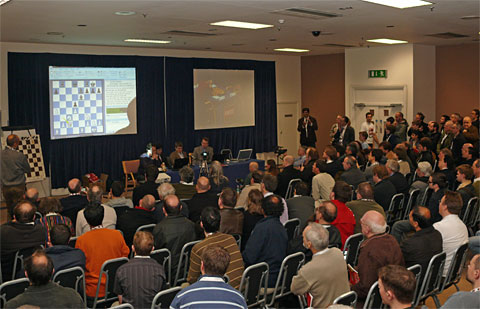
Packed audience for the analysis session after Carlsen vs Nakamura

Every seat and all the standing room taken in the commentary section
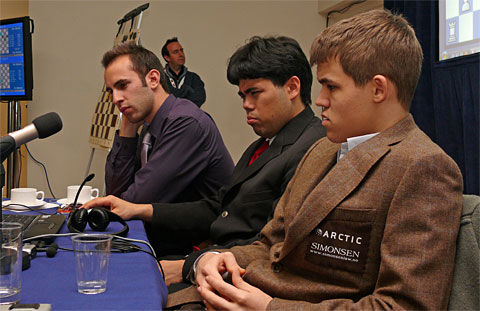
Lawrence Trent, Hikaru Nakamura and Magnus Carlsen discuss the game
The last game to finish was Nigel Short versus Ni Hua. Short won a pawn in the early middlegame but lost his way and couldn’t make anything of it, though the game went right down to the last pawn. But the players received a reward for their endeavour: they shared the best game of the round prize of 1,000 euros.

The start of the game Ni Hua vs Magnus Carlsen

Chinese GM Ni Hua facing former World Championship challenger Nigel Short
Short,Nigel (2707) - Ni Hua (2665) C11
London Chess Classic London ENG (4), 12.12.2009 [John Saunders]
1.e4 e6 2.d4 d5 3.Nc3 Nf6 4.Bg5 dxe4. The Burn Variation, so-called not because it is hot to the touch, but because it was played in the 1890s by Amos Burn (1848-1925), a very strong player from Yorkshire. Ceding the centre in this way makes it slightly less challenging than other moves such as 4...Bb4 or 4...Be7. 5.Nxe4 Nbd7 6.Nxf6+ Nxf6 7.c3 h6 8.Bh4 c5. 8...Be7 and 9...0-0 seems normal. The text is a little risky. 9.Bxf6. Back in 2001, in the first round of the Najdorf Memorial tournament in Buenos Aires, Nigel Short continued 9.Qf3 against Viktor Korchnoi and the game continued 9...Be7 10.Bb5+ Nd7 11.Bxe7 Qxe7 12.Ne2 0-0 13.0-0 Nf6 14.Rfe1 Rd8 15.Rad1 Bd7 , agreed drawn. 9...gxf6 10.Qf3. White plans 11 0-0-0 whilst keeping an eye on the pawns at f6 and b7 and thinking about Bb5+. 10...cxd4. It has to be admitted that Ni Hua has the courage of his convictions. This is really very bold. 11.Bb5+ Ke7
|
Black opts to put his king on a very uncomfortable square. One major consolation for Black is that White has no dark-squared bishop to exploit sensitive squares along the a3-f8 diagonal of f6 but it is still problematic for him. 11...Bd7 12.Qxb7 Bxb5 13.Qxb5+ Qd7 14.Qxd7+ Kxd7 15.0-0-0 wins a pawn for White, though it may not be absolutely conclusive. 12.Ne2 Qd5. Few competition players would contemplate 12...dxc3? since 13.Rd1 is the obvious retort, chasing the queen away and threatening to use the open d-file to get at the boxed-in black king. The text is more or less obligatory. 13.Qxd5 exd5 14.Nxd4 f5. Played in order to use f6 as a haven for the king, though it doesn't do any favours for the c8 bishop which loses scope. But king safety has to be the priority here. 15.0-0-0 Kf6. The opening phase is over and has not been a success for Black. His pawn structure is poor and his two bishops as yet undeveloped and with restricted options. White would be quite confident of exploiting his chances here. 16.Ne2 Be6 17.Nf4 Rd8 18.Bc4 d4. This doesn't save the pawn, of course, but gives it up in a way which improves Black's position somewhat. 19.Bxe6 One snag with 19.Nxe6 is that it would leave opposite coloured bishops on the board and improve Black's chances of reaching a drawn endgame. 19...fxe6 20.Rxd4 Bc5 21.Rxd8 Rxd8 22.Nh3. White has gained a pawn but lost his momentum. Still, he could hope to exploit his material advantage from here. 22...h5 23.Re1 e5 24.Re2 e4 25.Kc2 h4 26.f3 Re8 27.fxe4 fxe4
|
Around here, White started losing the thread of the game. In the commentary room afterwards, Nigel Short was rather disconsolate, but in an entertaining, self-deprecatory way. He had some difficulty recalling what his thinking had been. "Why did I play this?" (after one move he regretted) "Perhaps because I am stupid...". 28.b4?! Bd6. 28...Bb6 would allow 29.c4 but after the text move White's queenside pawn advance is stymied and he has to deal with problems on the kingside as well. 29.Rf2+ Ke5 30.Ng1. Putting pieces on their original squares seems to be the theme of the tournament. It reminds me in a strange way that big-time tournament chess was "coming home" to the country where such events started back in 1851. However, this particular 'homecoming' move may not be the best. Short was asked why he hadn't played 30.Ng5 here. He repeated the question to himself: "Yes, why not Ng5...". The question remained hanging in the air unanswered. 30...Rg8 31.g3 White surrenders his extra pawn. 31.Ne2 is a possibility, since 31...e3 32.Rf7 Rxg2? can be answered very well by 33.Kd3 and White is better. 31...hxg3 32.hxg3 Rxg3 33.Ne2 Rf3 34.Rg2 Kd5 35.Nd4 Rh3 36.Nb5 Be5 37.Rd2+ Ke6 38.Nd4+ Bxd4 39.Rxd4 Rh2+ 40.Kb3 Re2. The position is now equal and could justifiably be agreed a draw. However, there are a few pitfalls for the unwary. 41.a4 e3 This may be a slight inaccuracy since the pawn gets cut off from its second defender and is soon lost. However, it is not a critical error: even with two pawns against three, they are all on the same side of the board and the position drawn with best play. 42.Kc4 Ra2 43.a5 e2 44.Re4+ Kd6 45.Kd3 b6 46.axb6 axb6 47.Rxe2 Rxe2 48.Kxe2 b5 49.Kd2!
|
As I wrote elsewhere, the king and pawn endgame is a dangerous animal. White's last move sets a deadly trap. 49...Ke6! This is the only move to draw. If 49...Ke5?? 50.Ke3! and White gains the 'opposition'.; 49...Kc6?? 50.Ke3! also wins for White. But you would expect most players with a rating of, say, 2200 or above to figure out the correct defence. A blunder in such a position by a 2600+ player would be a major sensation. 50.Kd1 Kd5 51.Kc2 Kd6. Again, White hopes for 51...Kc4?? when 52.Kd2 Kd5 53.Kd3 Kc6 54.Ke4! would eventually win the b-pawn and the game. 52.Kd2 Ke6 53.Ke3 Ke5 54.Kd3 Kd5 55.c4+. By playing this, White concludes his winning attempts, entertains the crowd a little and enables a draw to occur naturally without recourse to the arbiter. 55...bxc4+ 56.Kc3 Kc6 57.Kxc4 Kb6 58.b5 Kb7 59.Kc5 Kc7 60.b6+ Kb7 61.Kb5 Kb8 62.Kc6 Kc8 63.b7+ Kb8 64.Kb6. Stalemate. The players shared the daily best game prize of $1,000. 1/2-1/2. [Click to replay]
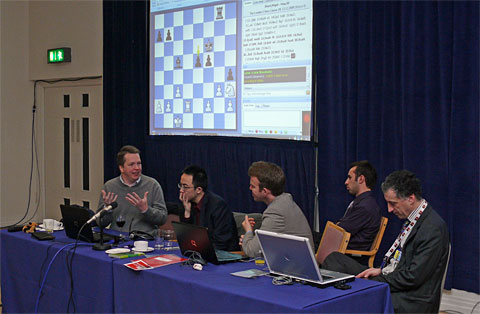
The most entertaining session: Nigel Short and Ni Hua (with Rowson,
Trent and Malcolm Pein)

A very young chess fan attentively follows Nigel's endgame analysis
All pictures by Frederic Friedel in London
|
Scoring System: 3 - Points per win 1 - Point per draw 0 - Points per loss |

|
|
||||||||||||||||||||||||||||||||||||||||||||
|
|
||||||||||||||||||||||||||||||||||||||||||||
|
|
||||||||||||||||||||||||||||||||||||||||||||
|
|
||||||||||||||||||||||||||||||||||||||||||||
| Monday | 7th December | Press Conference + blindfold display | |
Tuesday |
8th December |
Round 1 |
2.00pm |
Wednesday |
9th December |
Round 2 |
2.00pm |
Thursday |
10th December |
Round 3 |
2.00pm |
| Friday | 11th December | Rest day and Community / School events | |
Saturday |
12th December |
Round 4 |
2.00pm |
Sunday |
13th December |
Round 5 |
2.00pm |
Monday |
14th December |
Round 6 |
2.00pm |
Tuesday |
15th December |
Round 7 |
12.00pm |
LinksThe games will be broadcast live on the official web site and on the chess server Playchess.com. If you are not a member you can download the free PGN reader ChessBase Light, which gives you immediate access. You can also use the program to read, replay and analyse PGN games. New and enhanced: CB Light 2009! |